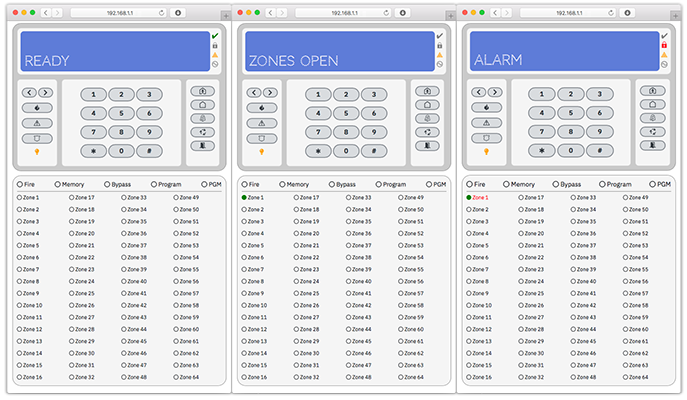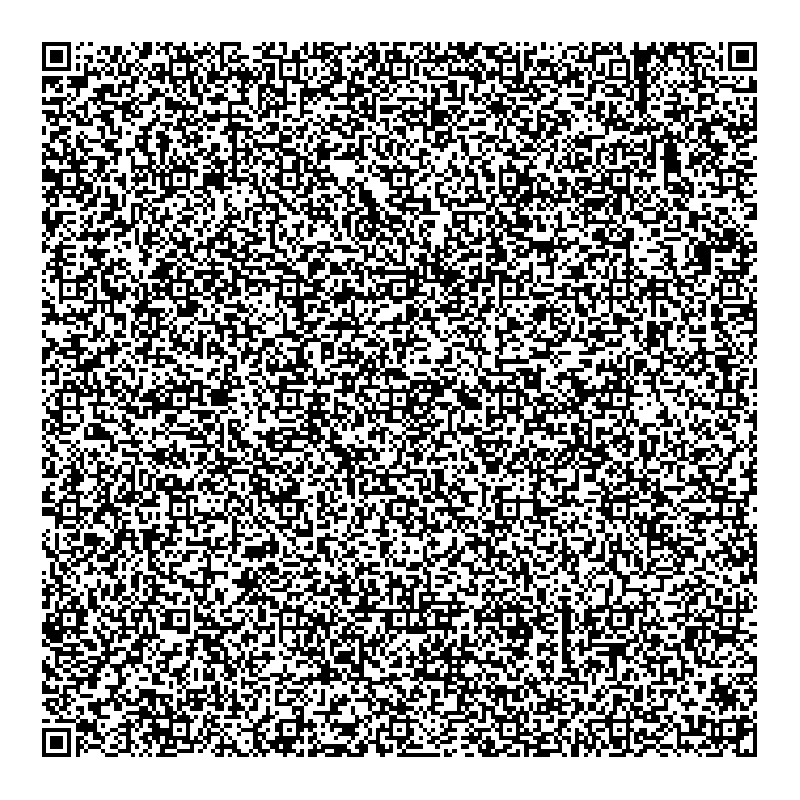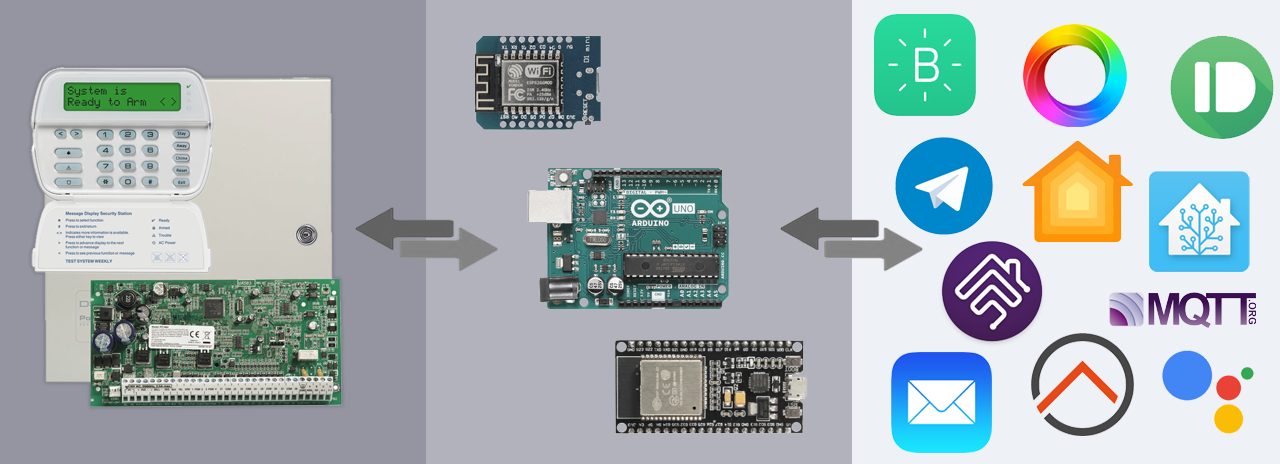 This library directly interfaces Arduino, esp8266, esp32, and esp32-s2 microcontrollers to DSC PowerSeries and Classic series security systems for integration with home automation, remote control as a virtual keypad, notifications on alarm events, unlocking installer codes, and emulating DSC panels to use DSC keypads as general purpose input devices.
This library directly interfaces Arduino, esp8266, esp32, and esp32-s2 microcontrollers to DSC PowerSeries and Classic series security systems for integration with home automation, remote control as a virtual keypad, notifications on alarm events, unlocking installer codes, and emulating DSC panels to use DSC keypads as general purpose input devices.
This enables existing DSC security system installations to retain the features and reliability of a hardwired system while integrating with modern devices and software for under $5USD in components.
The built-in examples can be used as-is or as a base to adapt to other uses:
- Home automation integration: Home Assistant, Apple HomeKit & Siri, Google Home, OpenHAB, Athom Homey
- Remote control: Web interface, Blynk mobile app, Telegram bot (with remote arming/disarming via chat)
- Notifications: Pushover, PushBullet, Pushsafer, Twilio SMS, TinyGSM SMS, E-mail
- Keypad interface: Emulates a DSC panel to connect DSC keypads as physical input devices for any general purpose, without a DSC panel.
- Installer code unlocking: Automatic code search to unlock panels with unknown installer codes
Example integrations:
- Apple Home & Siri:

- Home Assistant:

- OpenHAB MQTT:
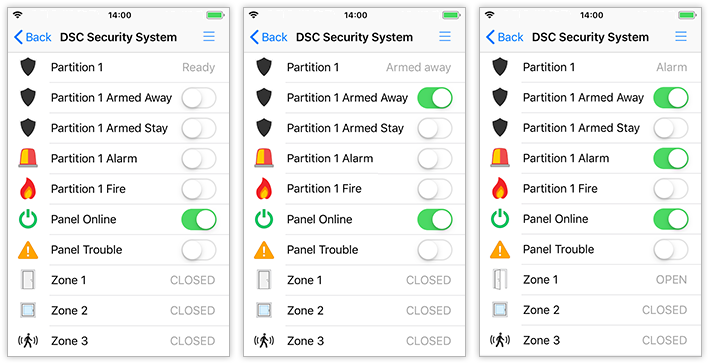
- Blynk app virtual keypad:

- Web virtual keypad:
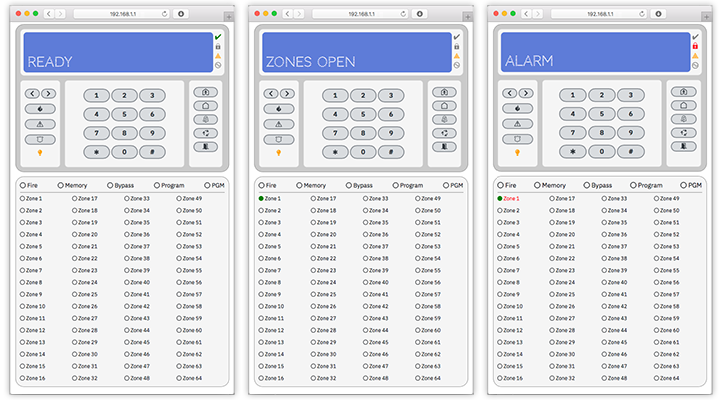
- Telegram bot:
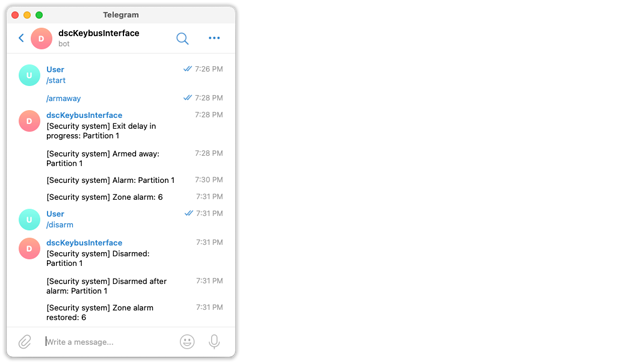
- Install the DSC Keybus Interface library:
- Arduino IDE: Search for
DSCin the Library Manager -Sketch > Include Library > Manage Libraries

- PlatformIO IDE: Search for
DSCin the PlatformIO Library Registry

- PlatformIO CLI:
platformio lib install "dscKeybusInterface" - Alternatively,
git cloneor download the repo .zip to the Arduino/PlatformIO library directory to keep track of the latest changes.
- Arduino IDE: Search for
- Select, configure, and upload one of the example sketches to the microcontroller:

- Connect the microcontroller to the DSC Keybus per the wiring diagram with the appropriate resistors (and a transistor if you'd like to control the system).
I Had: A DSC security system not being monitored by a third-party service.
I Wanted: Notification if the alarm triggered.
I was interested in finding a solution that directly accessed the pair of data lines that DSC uses for their proprietary Keybus protocol to send data between the panel, keypads, and other modules (instead of using the DSC IT-100 serial module). Tapping into the data lines is an ideal task for a microcontroller and also presented an opportunity to work with the Arduino and FreeRTOS (via esp-open-rtos) platforms.
While there has been excellent discussion about the DSC Keybus protocol and several existing projects, there were a few issues that remained unsolved:
- Error-prone Keybus data capture.
- Limited data decoding - there was good progress for armed/disarmed states and partial zone status for a single partition, but otherwise most of the data was undecoded (notably missing the alarm triggered state).
- Read-only - unable to control the Keybus to act as a virtual keypad.
- No implementations to do useful work with the data.
This library uses a combination of hardware and timer interrupts to accurately capture Keybus data, and has lead to reverse engineering much of the Keybus protocol.
- Monitor the status of all partitions:
- Alarm triggered, armed/disarmed, entry/exit delay, fire triggered, keypad panic keys
- Monitor zones status:
- Zones open/closed, zones in alarm
- Monitor system status:
- Ready, trouble, AC power, battery
- Monitor PGM outputs 1-14 status
- Virtual keypad:
- Write keys to the panel for all partitions
- Trigger panel command outputs
- Keypad interface:
- Emulates a DSC panel to use DSC PowerSeries and Classic series keypads as physical input devices for any general purpose, without needing a DSC panel.
- Panel time - retrieve current panel date/time and set a new date/time (including an example with NTP sync)
- Panel installer code unlocking - determine the 4-digit panel installer code
- Virtual zone expander - the expander branch can emulate a DSC zone expander module to add zones to the security system that are handled by the microcontroller - thanks to Dilbert66 for this contribution!
- Direct Keybus interface:
- Does not require the DSC IT-100 serial interface.
- Designed for reliable data decoding and performance:
- Hardware GPIO pin interrupts and timer interrupts for accurate data capture timing
- Data buffering: helps prevent lost Keybus data if the sketch is busy
- Extensive data decoding: the majority of Keybus data as seen in the DSC IT-100 Data Interface developer's guide has been reverse engineered and documented in
src/dscKeybusPrintData.cpp. - Non-blocking code: Allows sketches to run as quickly as possible without using
delayordelayMicroseconds
- Supported security systems:
- DSC PowerSeries - all panels are supported, tested with: PC585, PC1555MX, PC1565, PC1565-2P, PC5005, PC5010, PC5015, PC5020, PC1616, PC1808, PC1832, PC1864
- DSC Classic series: PC1500, PC1550, PC2550
- Requires configuring the panel through *8 programming to enable PC16-OUT: section 19, option 4.
- PC2500 and PC3000 are untested, post an issue if you're able to test these panels.
- Rebranded DSC PowerSeries (such as some ADT systems) should also work with this interface.
- Unsupported security systems:
- DSC Alexor (PC9155) is all wireless and does not have an accessible Keybus interface.
- DSC Neo series use a higher speed encrypted data protocol (Corbus) that is not currently possible to support.
- Other brands (that are not rebranded DSC systems) use different protocols and are not supported.
- For Honeywell Ademco Vista 15P/20P, see Dilbert66's esphome-vistaECP project
- For Paradox systems, see liaan's paradox-esp8266 project
- Supported microcontrollers:
- Arduino:
- Boards: Uno, Mega, Leonardo, Mini, Micro, Nano, Pro, Pro Mini
- ATmega328P, ATmega2560, and ATmega32U4-based boards at 16Mhz
- esp8266:
- Development boards: NodeMCU v2 or v3, Wemos D1 Mini, etc.
- Includes Arduino framework support and WiFi for ~$3USD shipped.
- esp32:
- Development boards: NodeMCU ESP-32S, Doit ESP32 Devkit v1, Wemos Lolin D32, etc.
- Includes Arduino framework support (v2.0.2 or newer required), dual cores, WiFi, and Bluetooth for ~$5USD shipped.
- esp32-s2:
- Includes Arduino framework support (v2.0.2 or newer required) and WiFi.
- Arduino:
- Possible features (PRs welcome!):
- DSC IT-100 emulation
- Unlock 6-digit installer codes
- 3.0
- New: DSC Classic series panel support: PC1500, PC1550, PC2550
- New:
KeypadInterfaceandKeypadInterface-MQTTexample sketches - emulate a DSC panel to connect DSC PowerSeries and Classic keypads as physical input devices for any general purpose, without needing a DSC panel. - New:
HomeKit-HomeSpanexample sketch (esp32) - integrate directly with Apple HomeKit as a native standalone accessory using HomeSpan - New: Pushover and Pushsafer push notification example sketches for esp8266/esp32
- New: esp32-s2 microcontroller support
- New: Code restructured to support new features from sketches using #define flags - enables Classic series support and
KeypadInterface. - Updated:
Homebridge-MQTTsupports switching armed modes while armed - Updated: Added TLS root certificate to
Twilio-SMS - Updated: removed deprecated
handlePanel() - Bugfix:
VirtualKeypad-Webupdated notes to switch to this fork of ESPAsyncWebServer to resolve crashes with iOS and macOS clients. - Bugfix:
Pushbulletexample sketch updated TLS security certificate fingerprint - Bugfix: Workaround for upstream esp32 TLS handshake issue preventing making a TLS connection more than once.
- Bugfix: Fixed
Homebridge-MQTThandling exit delay states while multiple partitions are arming - Bugfix: Resolved access codes not updating on disarm, changed arming access codes to update before armed status changes
- 2.0
- New: Telegram bot example sketch
- New: OpenHAB integration example sketch using MQTT
- New:
Unlockerexample sketch - determines the panel installer code - New:
TimeSyncNTPexample sketch - uses NTP to automatically set the panel time - New: ESPHome integration example (located in the
extrasdirectory) - thanks to Dilbert66 for this contribution! - New:
TinyGSM-SMSexample sketch - sends status via SMS with a GSM modem - thanks to jvitkauskas for this contribution! - New:
KeybusReaderIPexample sketch enables Keybus data access over IP, thanks to aboulfad for this contribution! - New: esp32 microcontroller support - requires Arduino-esp32 v1.0.5-rc6 or newer
- New: Features for sketches:
readyanddisabledtrack partition statussetTime()sets the panel date and timepgmOutputs[]tracks the status of PGM outputs 1-14timestampChangedtracks when the panel sends a timestampaccessCodetracks the access code used to arm/disarmresetStatus()triggers a full status update of all partitions and zones - for example, after initialization or a lost network connection.pauseStatuspauses status updates if set totrue- for example, holding status changes during a lost network connectionstop()disables the interface - for example, prior to starting OTA updatesappendPartition()in example sketches simplifies adding partition numbers to messagespanelVersiontracks the panel version number
- New: Handle
*1 bypass/re-activateused to change stay/away mode while armed - Updated:
VirtualKeypad-BlynkandVirtualKeypad-Webdisplay alarm memory, programming zone lights, and event buffer - Updated:
HomeAssistant-MQTT, Homebridge-MQTT, OpenHAB-MQTTinclude PGM outputs 1-14 status - Updated: Virtual keypad writes
write()for multiple keys can now be set to block until the write is complete with an optional parameter if the char array is ephemeral- Checking
writeReadyis typically no longer needed in the sketch, the library will block if a previous write is in progress - this can be checked if the sketch needs to wait until the library can perform a nonblocking write
- Updated:
HomeAssistant-MQTTsketch now includes night arm and for esp8266/esp32 includes a sensor with partition status messages - Updated: Expanded partition state processing to improve panel state detection at startup
- Deprecated:
handlePanel()is nowloop() - Bugfix: Resolved keypad aux/panic key, AC power, and battery status on PC585/PC1555MX
- Bugfix: Resolved
Homebridge-MQTTsketch not handling HomeKit target states - Bugfix: Resolved timing issues when consecutively calling
write
- 1.2
- New: Virtual keypad web interface example, thanks to Elektrik1 for this contribution!
- As of esp8266 Arduino Core 2.5.1, you may need to manually update the esp8266FS plugin for SPIFFS upload.
- New: Support esp8266 CPU running at 160MHz - this helps sketches using TLS through BearSSL
- Updated: HomeAssistant-MQTT example includes availability status, thanks to bjrolfe for this contribution!
- Updated: List of tested DSC panels: PC585, PC1565, PC5005, PC1808
- Updated: esp8266 power wiring diagrams
- Updated: esp8266 module list
- New: Virtual keypad web interface example, thanks to Elektrik1 for this contribution!
- 1.1
- 1.0
- New: Blynk virtual keypad example sketch and app layout examples
- New: Virtual keypad support for PGM terminals 1-4 command output
- New: Status
keybusConnectedto check if data is being received from the DSC panel - New: Auxiliary input alarm decoding
- 0.4
- New: Virtual keypad support for partitions 3-8, thanks to jvitkauskas for contributing the necessary logs
- New: Support ATmega32U4-based Arduino boards (switched to AVR Timer1)
- Changed: Simplified example names, configurations, added version numbers
- Bugfix: Virtual keypad writes with partitions 5-8 enabled
- Bugfix: F/A/P alarm key writes with
processModuleDatadisabled - Bugfix: HomeAssistant example
configuration.yamlerror foralarm_control_panel
- 0.3
- New: Status for partitions 2-8, zones 33-64
- New: Virtual keypad support for partition 2
- New: Athom Homey integration example sketch, thanks to MagnusPer for this contribution!
- New: PCB layouts, contributed by sjlouw
- New: Configurable number of partitions and zones to customize memory usage:
dscPartitionsanddscZonesindscKeybusInterface.h - New: KeybusReader decoding of commands
0xE6and0xEB - Changed: Split examples by platform
- Changed: Arduino sketches no longer use pin 4 to avoid a conflict with the SD card on Ethernet shields.
- Changed: MQTT examples updated with username and password fields
- Changed:
processRedundantDatanow true by default to prevent storing repetitive data, reduces memory usage. - Note: This release changes the library methods to accommodate multiple partitions, existing sketches will need to be updated to match the new example sketches.
- 0.2
- New: Status for zones 9-32
- New: Home Assistant integration example sketch
- New: Panel data buffering, adds
dscBufferSizetodscKeybusInterface.hto allow configuration of how many panel commands are buffered to customize memory usage (uses 18 bytes of memory per command buffered).
- 0.1 - Initial release
The included examples demonstrate how to use the library and can be used as-is or adapted to integrate with other software. Post an issue/pull request if you've developed (and would like to share) a sketch/integration that others can use.
-
Status: Processes and prints the security system status to a serial interface, including reading from serial for the virtual keypad. This demonstrates how to determine if the security system status has changed, what has changed, and how to take action based on those changes. Post an issue/pull request if you have a use for additional system states - for now, only a subset of all decoded commands are being tracked for status to limit memory usage:
- Partitions ready
- Partitions armed away/stay/disarmed
- Partitions in alarm
- Partitions exit delay in progress
- Partitions entry delay in progress
- Partitions fire alarm
- Zones open/closed
- Zones in alarm
- PGM outputs 1-14
- Keypad fire/auxiliary/panic alarm
- Get/set panel date and time
- User access code number (1-40)
- Panel AC power
- Panel battery
- Panel trouble
- Keybus connected
-
HomeKit-HomeSpan (esp32): Integrates directly with Apple HomeKit as a native accessory (for the Home app and Siri) using HomeSpan, without needing a separate service or device. Demonstrates arming/disarming partitions, zones status, fire alarms, PGM outputs status, and controlling panel command outputs.
- For esp8266, the dscKeybusInterface-RTOS library includes a native HomeKit implementation that runs directly on the esp8266, without requiring a separate device running MQTT or Homebridge.
-
Homebridge-MQTT: Interfaces with Homebridge via MQTT to integrate with Apple HomeKit (including the iOS Home app and Siri) and Google Home. Demonstrates arming/disarming partitions and for HomeKit, viewing the status of zones, PGM outputs, and fire alarms.
-
HomeAssistant-MQTT: Interfaces with Home Assistant via MQTT. Demonstrates arming/disarming partitions and viewing the status of zones, PGM outputs, fire alarms, and trouble. For esp8266/esp32, the partition status is available as a text message for display.
-
OpenHAB-MQTT: Interfaces with OpenHAB via MQTT. Demonstrates using the panel and partitions states as OpenHAB switches and zone states as OpenHAB contacts. For esp8266/esp32, a panel status message is also sent as a string to OpenHAB. See https://github.com/jimtng/dscalarm-mqtt for an integration using the Homie convention for OpenHAB's Homie MQTT component.
-
ESPHome (esp8266): Integrates with ESPHome as a custom component - note that this example is located in the
extrasdirectory. Thanks to Dilbert66 for this contribution! -
Homey: Integrates with Athom Homey and the Homeyduino library, including armed, alarm, and fire states (currently limited to one partition), and zone states. Thanks to MagnusPer for contributing this example!
-
Telegram (esp8266/esp32): Demonstrates sending status updates as push notifications and arming/disarming the security system via a Telegram bot. Supports iOS, Android, and macOS/Windows/Linux desktop notifications (free).
-
Pushover (esp8266/esp32): Demonstrates sending status updates as push notifications via Pushover. Supports iOS, Android, macOS native desktop notifications, and Chrome/Firefox/Safari browser popups ($4.99USD one-time purchase per client platform).
-
Pushbullet (esp8266/esp32): Demonstrates sending status updates as push notifications via Pushbullet. Supports Android, Windows desktop notifications, and Chrome/Firefox browser popups (free). Note that iOS is no longer supported.
-
Pushsafer (esp8266/esp32): Demonstrates sending status updates as push notifications via Pushsafer. Supports iOS, Android, Windows desktop notifications, and Chrome/Firefox/Edge/Opera/Yandex browser popups (€0.99EUR or less per 1000 notifications).
-
Twilio-SMS (esp8266/esp32): Demonstrates sending status updates as SMS text messages via Twilio - thanks to ColingNG for contributing this example!
-
Email (esp8266/esp32): Demonstrates sending status updates as email. Email is sent using SMTPS (port 465) with SSL for encryption - this is necessary on the esp8266/esp32 until STARTTLS can be supported. For example, this will work with Gmail after changing the account settings to allow less secure apps.
This can be used to send SMS text messages if the number's service provider has an email to SMS gateway - examples for the US:
- T-mobile: [email protected]
- Verizon: [email protected]
- AT&T: [email protected]
-
VirtualKeypad-Blynk (esp8266/esp32): Provides a virtual keypad interface for the free Blynk legacy app on iOS and Android, including viewing alarm memory, programming zone lights, and the event buffer. The newer generation Blynk app is not currently supported. Scan one of the following QR codes from within the Blynk app for an example keypad layout:
Note: Installing Blynk as a local server is recommended to keep control of the security system internal to your network.
-
VirtualKeypad-Web (esp8266/esp32): Provides a virtual keypad web interface, using the esp8266/esp32 itself as a standalone web server, including viewing alarm memory, programming zone lights, and the event buffer. Thanks to Elektrik1 for contributing this example!
-
TimeSyncNTP: Synchronizes and maintains time on PowerSeries panels via an NTP server, including DST adjustments.
-
Unlocker: Finds the 4-digit installer code for PowerSeries panels by checking all possible codes, including handling keypad lockout if enabled. The valid code is output to serial as well as repeatedly flashed with the built-in LED. Arduino checks each code sequentially but esp8266/esp32 may find the code more quickly as they check in order of the most commonly used general 4-digit codes.
-
KeypadInterface: Interfaces directly to DSC PowerSeries and Classic series (tested with PC1500RK) keypads (without a DSC panel) to enable using these as physical inputs for any general purpose. Examples included for interfacing via serial and MQTT. Note that this uses a different wiring setup from the standard Keybus interface, refer to the wiring diagram in the example sketch.
-
KeybusReader: Decodes and prints data from the Keybus to a serial interface, including reading from serial for the virtual keypad. This can be used to help decode the Keybus protocol and is also handy as a troubleshooting tool to verify that data is displayed without errors. For esp8266/esp32,
KeybusReaderIPenables connectivity over WiFi.See
src/dscKeybusPrintData.cppfor all currently known Keybus protocol commands and messages. Issues and pull requests with additions/corrections are welcome!
- dscalarm-mqtt: implementation of the Homie MQTT convention
- esphome-dsckeybus: implementation of this library as an ESPHome custom component
- PC1500KeybusReader: MQTT HomeKit example for the PC1500 and ESP32 using dougkpowers/pc1550-interface
DSC Aux(+) ---+--- Arduino Vin pin
|
+--- 5v voltage regulator --- esp8266 NodeMCU / Wemos D1 Mini 5v pin
esp32 development board 5v pin
DSC Aux(-) --- Arduino/esp8266/esp32 Ground
Arduino +--- dscClockPin (Arduino Uno: 3)
DSC Yellow ---+--- 15k ohm resistor ---|
| +--- 10k ohm resistor --- Ground
|
| esp8266/esp32 +--- dscClockPin (esp8266: D1, GPIO 5 / esp32: 18)
+--- 33k ohm resistor ---|
+--- 10k ohm resistor --- Ground
Arduino +--- dscReadPin (Arduino Uno: 5)
DSC Green ----+--- 15k ohm resistor ---|
| +--- 10k ohm resistor --- Ground
|
| esp8266/esp32 +--- dscReadPin (esp8266: D2, GPIO 4 / esp32: 19)
+--- 33k ohm resistor ---|
+--- 10k ohm resistor --- Ground
Classic series only, PGM configured for PC-16 output:
DSC PGM ------+--- 1k ohm resistor --- DSC Aux(+)
|
| Arduino +--- dscPC16Pin (Arduino Uno: 4)
+--- 15k ohm resistor ---|
| +--- 10k ohm resistor --- Ground
|
| esp8266/esp32 +--- dscPC16Pin (esp8266: D7, GPIO 13 / esp32: 17)
+--- 33k ohm resistor ---|
+--- 10k ohm resistor --- Ground
Virtual keypad (optional):
DSC Green ---- NPN collector --\
|-- NPN base --- 1k ohm resistor --- dscWritePin (Arduino Uno: 6 / esp8266: D8, GPIO 15 / esp32: 21)
Ground --- NPN emitter --/
- The DSC PowerSeries Keybus operates at ~12.6v and the Classic series operates at ~13.75v, a pair of resistors per data line will bring this down to an appropriate voltage for each microcontroller.
- Arduino:
- The DSC yellow (clock) line connects to a hardware interrupt pin - for the Uno, these are pins 2 or 3. The example sketches use dscClockPin: 3.
- The DSC green (data) line can be connected to any of the remaining digital pins 2-12. The examples sketches use dscReadPin: 5 and dscWritePin: 6.
- esp8266: connect the DSC lines to GPIO pins that are normally low to avoid putting spurious data on the Keybus: D1 (GPIO5), D2 (GPIO4) and D8 (GPIO15). The example sketches use dscClockPin: D1, dscReadPin: D2, dscWritePin: D8. For the Classic series, dscPC16Pin: D7 (GPIO 13).
- esp32: connect the DSC lines to GPIO pins that do not send signals at boot: 4, 13, 16-39. For virtual keypad, use pins 4, 13, 16-33 - pins 34-39 are input only and cannot be used. The example sketches use dscClockPin: 18, dscReadPin: 19, dscWritePin: 21. For the Classic series, dscPC16Pin: 17.
- Arduino:
- Virtual keypad uses an NPN transistor and a resistor to write to the Keybus. Most small signal NPN transistors should be suitable, for example:
- 2N3904
- BC547, BC548, BC549
- That random NPN at the bottom of your parts bin (my choice)
- Power:
- Arduino boards can be powered directly from the DSC panel
- esp8266/esp32 development boards should use an external voltage regulator set to 5v to the 5v pin:
- LM2596-based step-down buck converter modules are reasonably efficient and commonly available for under $1USD shipped (eBay, Aliexpress, etc) - these are the modules I use.
- MP2307-based step-down buck converter modules (aka Mini360) are also available but some versions run hot with an efficiency nearly as poor as linear regulators.
- Linear voltage regulators (LM7805, etc) will work but are inefficient and run hot - these may need a heatsink.
- esp8266/esp32 boards can also use an external voltage regulator set to 3.3v to the 3.3v pin - this bypasses the module's onboard voltage regulator. For example, some Wemos D1 mini clones use low current voltage regulators that can cause stability issues. NodeMCU boards are not affected as they use the more powerful AMS1117 regulator.
- Connections should be soldered, breadboards can cause issues.
This allows a sketch to send keys to the DSC panel to emulate the physical DSC keypads and enables full control of the panel from the sketch or other software.
Keys are sent to partition 1 by default and can be changed to a different partition. The following keys can be sent to the panel - see the examples for usage:
- Keypad:
0-9 * # - Arm stay (requires access code if quick arm is disabled):
s - Arm away (requires access code if quick arm is disabled):
w - Arm with no entry delay (requires access code):
n - Fire alarm:
f - Auxiliary alarm:
a - Panic alarm:
p - Door chime enable/disable:
c - Fire reset:
r - Quick exit:
x - Change partition:
/+partition numberor setwritePartitionto the partition number. Examples:- Switch to partition 2 and send keys:
/2+1234 - Switch back to partition 1:
/1 - Set directly in sketch:
dsc.writePartition = 8;
- Switch to partition 2 and send keys:
- Command output 1:
[ - Command output 2:
] - Command output 3:
{ - Command output 4:
}
Panel options affecting this interface, configured by *8 + installer code - see the Unlocker sketch if your panel's installer code is unknown. Refer to the DSC installation manual for your panel to configure these options:
-
PC1555MX/5015 section
370, PC1616/PC1832/PC1864 section377:-
Swinger shutdown: By default, the panel will limit the number of alarm commands sent in a single armed cycle to 3 - for example, a zone alarm being triggered multiple times will stop reporting after 3 alerts. This is to avoid sending alerts repeatedly to a third-party monitoring service, and also affects this interface. As I do not use a monitoring service, I disable swinger shutdown by setting this to
000. -
AC power failure reporting delay: The default delay is 30 minutes and can be set to
000to immediately report a power failure.
-
-
PC1500/PC1550 Classic series - the following configuration is required to get the security system status:
- Communicator: Enable in section
12, option1to support PC16-OUT mode - PC16-OUT: Enable section
13, option4to set the PGM output to PC16-OUT mode to send required panel status data on the Keybus. - PGM output: Enable section
24, option08to set the PGM output to trigger while the system alarm is tripped (works together with PC16-OUT mode).
- Communicator: Enable in section
-
For OTA updates on esp8266 and esp32, you may need to stop the interface using
dsc.stop();:void setup() { ... ArduinoOTA.onStart([]() { dsc.stop(); ... -
Memory usage can be adjusted based on the number of partitions, zones, and data buffer size specified in
src/dscKeybus.horsrc/dscClassic.h. Default settings:- Arduino: up to 4 partitions, 32 zones, 10 buffered commands
- esp8266/esp32: up to 8 partitions, 64 zones, 50 buffered commands
-
PCB layouts are available in
extras/PCB Layouts- thanks to sjlouw for contributing these designs! -
Support for other platforms depends on adjusting the code to use their platform-specific timers. In addition to hardware pin-change interrupts to capture the DSC clock, this library uses platform-specific timer interrupts to capture the DSC data line in a non-blocking way 250μs after the clock changes (without using
delayMicroseconds()). This is necessary because the clock and data are asynchronous - I've observed keypad data delayed up to 160μs after the clock falls. -
Resource utilization:
- Arduino: 1 hardware interrupt digital pin, 2 digital pins (+1 for Classic series), Timer1 interrupt
- esp8266: 3 digital pins (+1 for Classic series), timer1 interrupt
- esp32/esp32-s2: 3 digital pins (+1 for Classic series), timer0 interrupt
If you are running into issues:
- Run the
KeybusReaderexample sketch and view the serial output to verify that the interface is capturing data successfully without reporting CRC errors.- If data is not showing up or has errors, check the clock and data line wiring, resistors, and all connections. Breadboards can cause issues, connections should be soldered instead.
- For virtual keypad, run the
KeybusReaderexample sketch and enter keys through serial and verify that the keys appear in the output and that the panel responds.- If keys are not displayed in the output, verify the transistor pinout, base resistor, and wiring connections.
- Run the
Statusexample sketch and view the serial output to verify that the interface displays events from the security system correctly as partitions are armed, zones opened, etc.
For general discussions, feature requests, or how-to issues, you can post in Discussions, or post an Issue if it looks like an issue with the library code itself.
AVR Freaks - DSC Keybus Protocol: An excellent discussion on how data is sent on the Keybus.
stagf15/DSC_Panel: A library that nearly works for the PC1555MX but had timing and data errors. Writing this library from scratch was primarily a programming exercise, otherwise it should be possible to patch the DSC_Panel library.
dougkpowers/pc1550-interface: An interface for the DSC Classic series.








